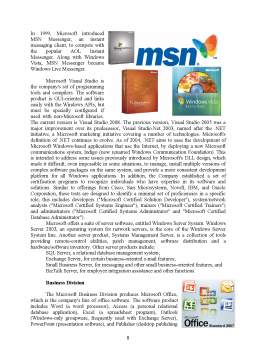Cuprins
- Introduction 3
- Company History 4
- Business and User Culture 6
- Product Divisions 7
- Production Process 10
- Corporate Structure 17
- Buyer Behavior 19
- Distribution 20
- Market 22
- Promotion 26
- Conclusion 28
- Annexes 29
- References 32
Extras din proiect
The Microsoft Corporation
Introduction
Microsoft Corporation is an American multinational computer technology corporation with 79,000 employees in 102 countries and global annual revenue of US $51.12 billion as of 2007. It develops, manufactures, licenses and supports a wide range of software products for computing devices. Headquartered in Redmond, Washington, USA, its best selling products are the Microsoft Windows operating system and the Microsoft Office suite of productivity software. These products have prominent positions in the desktop computer market, with market share estimates as high as 90% or more as of 2003 for Microsoft Office and 2006 for Microsoft Windows, in line with Bill Gates's vision "to get a workstation running our software onto every desk and eventually in every home”.
Founded to develop and sell BASIC interpreters for the Altair 8800, Microsoft rose to dominate the home computer operating system market with MS-DOS in the mid-1980s. The company released an initial public offering in the stock market, which, due to the ensuing rise of the stock price, has made four billionaires and an estimated 12,000 millionaires from Microsoft employees. Throughout its history the company has been the target of criticism for various reasons, including monopolistic business practices, both the U.S. Justice Department and the European Commission, among others, brought Microsoft to court for antitrust violations and software bundling.
Microsoft has footholds in other markets besides operating systems and office suites, with assets such as the MSNBC cable television network, the MSN Internet portal, and the Microsoft Encarta multimedia encyclopedia. The company also markets both computer hardware products such as the Microsoft mouse and home entertainment products such as the Xbox, Xbox 360, Zune and MSN TV. Known for what is generally described as a developer-centric business culture, Microsoft has historically given customer support over Usenet newsgroups and the World Wide Web, and awards Microsoft MVP status to volunteers who are deemed helpful in assisting the company's customers. The company's official website is one of the most visited on the Internet, receiving more than 2.4 million unique page views per day according to Alexa.com, who ranked the site 18th amongst all websites for traffic rank on September 12, 2007.
Company History
Following the launch of the Altair 8800, Bill Gates called the creators of the new microcomputer, Micro Instrumentation and Telemetry Systems (MITS), offering to demonstrate an implementation of the BASIC programming language for the system. After the demonstration, MITS agreed to distribute Altair BASIC. Bill Gates left Harvard University, moved to Albuquerque, New Mexico where MITS was located, and founded Microsoft there. The company's first international office was founded on November 1, 1978, in Japan, entitled "ASCII Microsoft", now called "Microsoft Japan". On January 1, 1979, the company moved from Albuquerque to a new home in Bellevue, Washington. Steve Ballmer joined the company on June 11, 1980, and later succeeded Bill Gates as CEO.
DOS (Disk Operating System) was the operating system that brought the company its first real success. On August 12, 1981, after negotiations with Digital Research failed, IBM awarded a contract to Microsoft to provide a version of the CP/M operating system, which was set to be used in the upcoming IBM Personal Computer (PC). For this deal, Microsoft purchased a CP/M clone called 86-DOS from Seattle Computer Products, which IBM renamed to PC-DOS. Later, the market saw a flood of IBM PC clones after Columbia Data Products successfully cloned the IBM BIOS, and by aggressively marketing MS-DOS to manufacturers of IBM-PC clones, Microsoft rose from a small player to one of the major software vendors in the home computer industry. The company expanded into new markets with the release of the Microsoft Mouse in 1983, as well as a publishing division named Microsoft Press.
In August 1985, Microsoft and IBM partnered in the development of a different operating system called OS/2. On November 20, 1985, Microsoft released its first retail version of Microsoft Windows, originally a graphical extension for its MS-DOS operating system. On March 13, 1986 the company went public with an IPO, with a starting initial offering price of $21.00 and ending at the first day of trading as at US $28.00. In 1987, Microsoft eventually released their first version of OS/2 to OEMs. The Redmond Microsoft campus today includes more than 8 million square feet, approx. 750,000 m˛ and over 30,000 employees.
Preview document
Conținut arhivă zip
- Project in Business Administration - The Microsoft Corporation.doc









































